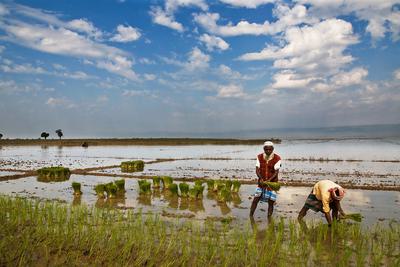Farmers planting a rice paddy field in Bangladesh. Balaram Mahalder / Wikimedia
The world could feed an additional 825 million people, produce 10 percent more food calories, and grow 19 percent more protein simply by adjusting what crops are grown where, according to a new study in the journal Nature Geoscience.
The study looked at 14 crops that make up 72 percent of all agricultural plants grown throughout the world, analyzing where the crops are grown and how much water is required to grow them versus water availability. The scientists were then able to pinpoint more suitable locations for each of the 14 crops, which included groundnut, maize, millet, oil palm, rapeseed, rice, roots, sorghum, soybean, sugar beet, sugarcane, sunflowers, tubers, and wheat.
“A big problem is that the current distribution of crops around the world doesn’t maximize yields or minimize water use,” lead author Kyle Davis, of Columbia University, told The Nature Conservancy. “So we set out to completely rethink agriculture to see if there was a better way.”
The analysis finds that in western Russia, for example, rain-fed sorghum, soybeans, tubers, and wheat should be replaced by millets, sugar beet, and sunflowers. In Northern India, farmers should grow rice, sorghum, and wheat rather than their current crops of maize, millet, roots, and tubers. The research was led by scientists at the University of Virginia, Columbia University’s Earth Institute, and Politecnico di Milano in Italy.
Changing where crops are grown would not only help increase agricultural yields and feed more people, the study finds, it would also reduce farmers’ use of rainwater by an estimated 14 percent and cut irrigation water by 12 percent. Crop redistribution could also be done without massive technology investments, loss of crop diversity, or a decline in soil nutrients, the researchers say. But they did acknowledge that cultural and dietary preferences could pose a challenge in changing where crops are grown.
“The next step for this work,” Davis said, “is to work with collaborators and policy-makers in populous developing countries – like India and Nigeria – to tailor this type of solution to local goals and needs. Our models look good, but there are obviously a lot of other considerations, which are different for each country, that go into developing policy solutions for more sustainable food systems.”




